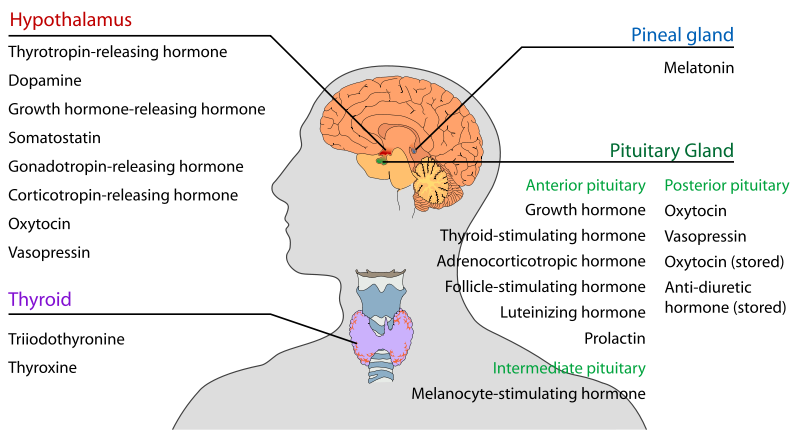
Growth hormone
Growth hormone, also known as the somatotropic hormone or somatotropin, is produced by the somatotrophs. It is an important hormone for growth and development.Functions of Growth Hormone
Effects on Growth:
Growth hormone effects growth by:a. Increasing the number of cells.
b. Increasing the size of the cells.
c. Increasing the differentiation of cells
Metabolic Effects
Growth hormone has metabolic effects ona. Proteins
Growth hormone decreases the utilization of proteins in the body by:1. Increase in protein deposition in the cells
2. Increase in DNA transcription
3. Increase in RNA translation
4. Increase in amino acid transport
5. Decrease in protein catabolism
b. Carbohydrates
A decrease carbohydrate utilization is observed along with a decrease in glucose uptake by the tissues, accompanied by increased glucose production by the liver. An increase in insulin production is also observed, but it is unable to mediate its effects of decreasing glucose levels in blood (this is attributed to the increased levels of free fatty acids, which hinder the effects of insulin). Thus growth hormone is a diabetogenic hormone producing pituitary diabetes (due to overproduction of glucose and decreased utilization).c. Fats
Growth hormone increases the utilization of fats and increases fat mobilization. It causes an increase in the levels of free fatty acids in the plasma. The levels of acetyl Co-A (produced from the free fatty acids) also rise in the body, thus fats are used for providing energy to a greater extent, while carbohydrates are spared. Thus, under the influence of growth hormone, an increase in lean body mass is observed. Increased production of acetyl Co-A also lead to increased formation of ketone bodies, thus causing ketosis.Effects on bones
Growth hormone causes:a. increased deposition of proteins by chondrocytes and osteoblasts
b. increased reproduction of chondrocytes and osteoblasts
c. conversion of chondrocytes into osteocytes
Mechanisms of bone growth
There are two ways in which bones grow:a. Longitudinal growth
Longitudinal growth involves the increase in bone length which occurs at the epiphyseal plates. The chondrocytes undergo mitosis and there is deposition of new cartilage. Ossification of new cartilage results in the formation of new bone. There is, thus, elongation of shaft in longitudinal growth.b. Horizontal growth
The horizontal growth involves the increase in bone thickness. The osteoblasts deposit new bone while the osteoclasts remove the old bone. The rate of deposition of bone is greater than the rate of resorption. There is ,thus, increase in thickness of the shaft.Somatomedins:
Somatomedins are small proteins synthesized in liver under the influence of growth hormone. These are also known as Insulin-like growth factor (IGF). They increase all aspects of bone growth. Somatomedins have longer half life than growth hormone. There are four major somatomedins, but the most important is the somatomedin C (IGF-I).African pygmies have a congenital inability to synthesize somatomedin C. Their plasma growth hormone levels are normal or high, but they remain small statured. The Levi-Lorain dwarves have the same problems.
Regulation of GH
Hypothalamus releases growth hormone releasing hormone (GHRH) which increases the production of growth hormone. It also releases growth hormone inhibitory hormone (GHIH), which inhibits the production of growth hormone.The GHRH acts through the cAMP dependent 2nd messenger system.Short term influences are mediated through the calcium influx while the long term effects through the transcription and new hormone synthesis.
Growth Hormone and Aging
Growth hormone is also known as anti-aging hormone as is evident from the growth hormone levels during different periods of life:a. 5-20 yrs —- 6 ng/ml
b. 20-40 yrs — 3 ng/ml
c. 40-60 yrs — 1.6 ng/ml